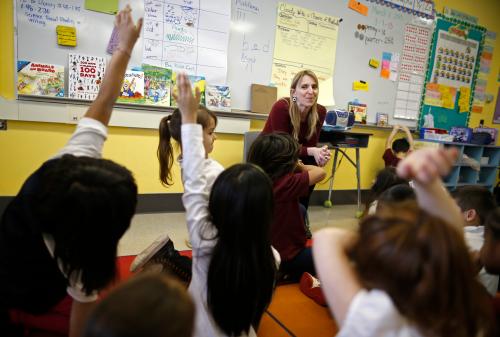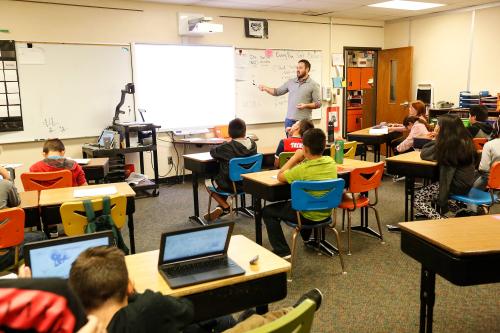This post is part of “Teacher diversity in America,” a series from the Brown Center on Education Policy that examines minority underrepresentation among public educators in the U.S.
Last month, Virginia Gov. Terry McAuliffe signed Executive Directive 14 to address the state’s growing teacher shortage and simultaneously announced budget actions to target the recruitment and retention of qualified teachers, particularly teachers of color.
Virginia is not the only state to focus on teacher diversity when attempting to remedy teacher shortages. Last April, the Tennessee Department of Education announced a strategy to address its shortages that included grant funding to districts for developing plans to increase teacher diversity. Teacher and education policy groups in Minnesota have argued for policy remedies that attempt to provide a combined approach to tackling both problems.
These states are all looking to merge two important—though usually separate—conversations about the status of the teacher workforce nationally: teacher shortages and the lack of minority representation among teachers. Addressing these issues with an integrated strategy seems entirely sensible in light of their common focus on the pipeline bringing new teachers into the profession. In this post, the latest in our teacher diversity series, we examine the extent to which these issues overlap in practice.
To begin, it’s helpful to notice the common setting for these staffing issues. Though the extent of the teacher shortage is debated, shortages occur when teaching vacancies are exceptionally difficult to fill or even go unfilled into the school year. Staffing vacancies arise most commonly after teachers have voluntarily left a school—whether it be for a different post elsewhere or due to leaving the profession altogether. This fact alone means that vacancies will be most concentrated in schools with high turnover, which tend to be those schools that serve high-poverty, high-minority student bodies.
These same schools are also important from a workforce diversity angle. The high concentration of minority students implies a higher need for minority teachers in these schools to minimize the incidence of racial mismatch and its effects on students.
Due to these common settings for both problems, it is easy to presume that both are closely associated; in other words, schools with shortages need minority teachers most. Therefore, policies to tackle one problem should implicitly tackle the other. But is that actually the case? How are minorities represented in schools most feeling the teacher shortage pinch?
Given existing evidence, unfortunately, it’s unclear whether we should expect shortages in the same places where we expect low shares of minority teachers. On one hand, states with high numbers of hard-to-fill vacancies may promote reforms to licensure policies that result in lower barriers to entry, and presumably a more diverse workforce. Although there is no evidence of a causal relationship between lowering entry barriers and minority representation, minorities have demonstrably lower passage rates on licensure tests (and these lower passage rates do not appear to signal lower quality) and are somewhat less common in states with higher testing standards. Similarly, alternative certification routes like Teach for America are known for being one of the most diverse pathways into the teaching profession. Hence, shortages could pressure states to adopt alternative certification policies that may result in greater minority representation in the workforce. In this case, we may witness increasing workforce diversity in states that recently experienced or are currently experiencing shortages.
On the other hand, hostile or undesirable work environments may induce more teacher turnover, which causes more vacancies that may be difficult to fill. Because recent evidence suggests teachers of color have higher quit rates in the face of low administrative support—particularly when they are significantly under-represented among the school’s teachers—we might predict workforce diversity to be low in places with teacher shortages.
In light of states adopting policies designed to target both issues (shortages and low workforce diversity) simultaneously, we think it’s important to develop a better understanding of whether these problems tend to occur concurrently. To explore the shortage-diversity relationship, we dig into data from the most recent Schools and Staffing Survey (SASS), a nationally representative survey administered by the National Center for Education Statistics in the Department of Education. The SASS asks schools whether they had a vacancy (by subject), and if so, how easy or hard it was to fill.
Figure 1 plots the share of minority teachers and minority students in schools that report a vacancy in special education, English, social studies, or STEM (combining math, biology, computer science and physical sciences) and in schools without a vacancy in each of those subjects.[1]

Consistent with prior evidence, we find that schools with vacancies had slightly higher shares of minority students. Figure 1 also shows such schools also had slightly higher shares of minority teachers. Additionally, the share of minority teachers looks roughly the same regardless of the subject the vacancy is seeking to hire.
It is also worth noting that the presence of vacancies in a school varies by subject: On the low end, about a quarter of schools reported vacancies in social studies, while more than 45 percent of schools reported a vacancy in a STEM subject.
The above figure treats all vacancies the same, but shortages are marked by the presence of hard-to-staff vacancies. Figure 2 plots the breakdown of schools with vacancies by how easy these vacancies were to fill.

Here we see that schools that had a harder time filling the vacancy have a slightly more diverse student body than schools where it was easy to fill the vacancy. Interestingly, though, minority teacher representation increases in schools with hard-to-fill vacancies. Further, the marginal increase in minority teacher representation in schools with hard-to-fill vacancies is even higher than the analogous increase among minority students across three of the four subject areas (special education excluded). The change in demographics among hard-to-fill social studies posts visually stands out in Figure 2, though these numbers are drawn from a comparatively small sample of schools (51) that fall into that category.
Taking this one step further, in Figure 3 we look across subjects and tabulate the number of hard-to-fill vacancies in particular schools to look for changes in minority representation. We observe similar proportional increases in both teacher and student minority representation as the number of hard-to-fill vacancies goes up in a school (and, presumably, the likelihood of the school feeling like it faces a teacher shortage).

Looking across these data, we offer two concluding comments.
First, we see greater shares of minority students in schools where vacancies (and, presumably, shortages) are more acute. We also find progressively more minority teachers in these schools as well. While schools that had many hard-to-fill vacancies showed larger discrepancies between student and teacher representation (in terms of differences in percentage points), these differences were proportional to representation challenges in other schools. Hence, schools facing shortages—at least from this national perspective—do not show any systematic pattern of minority underrepresentation. Further, schools with many hard-to-fill vacancies had some of the highest teacher minority shares in the analysis. Hiring more minority teachers specifically to these schools would simply concentrate them where they already teach in high numbers.
Second, this evidence suggests the lack of minority representation among the teacher workforce and teacher shortages do not seem to be closely related, at least not spatially. We applaud the efforts of some states to increase teacher diversity and shortages simultaneously, but we should not assume that addressing one problem would implicitly fix the other.
Footnote
- We are looking at schools that post and hire teachers to subject-specific vacancies; thus, the sample is primarily (though not exclusively) made up of middle and high schools.








Commentary
Can states lean on diverse teacher recruitment to stem teacher shortages?
January 17, 2018